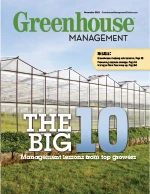|
Mechanical thermostats are still the major heating/cooling system control device in greenhouses. Although electronic thermostats, controllers and computers are readily available, they have not been widely adapted in the industry, probably due to their cost and unfamiliarity to growers. Selecting the right thermostat and locating it to sense plant temperature can save considerable fuel and electricity. Select a thermostat for greenhouse conditions The movement of the switch between the “on” signal and the “off” signal is called the differential. This can vary from 1°F to 8°F for mechanical thermostats. If you want to maintain a minimum 60°F (setpoint) in the greenhouse and have a thermostat with a 6°F differential, the furnace will start when the temperature falls to 60°F but doesn’t turn off until it reaches 66°F. This override overheats the greenhouse and increases both the heat loss and the heating cost. It is important to select a thermostat with a small differential. Some thermostats have a heat anticipator that shuts the furnace off just before the shut off point. This will save some fuel.
For more accurate control, consideration should be given to upgrading to a controller that integrates both the heating and cooling systems. This usually has a payback of less than three years.
John Bartok is a regular contributor to Greenhouse Management and an agricultural engineer and emeritus extension professor at the University of Connecticut. He is an author, consultant and a certified technical service provider doing greenhouse energy audits for USDA grant programs in New England. Have a question? You can write John at jbartok@rcn.com. |

Explore the November 2012 Issue
Check out more from this issue and find your next story to read.
Latest from Greenhouse Management
- Anthura acquires Bromelia assets from Corn. Bak in Netherlands
- Top 10 stories for National Poinsettia Day
- Langendoen Mechanical hosts open house to showcase new greenhouse build
- Conor Foy joins EHR's national sales team
- Pantone announces its 2026 Color of the Year
- Syngenta granted federal registration for Trefinti nematicide/fungicide in ornamental market
- A legacy of influence
- HILA 2025 video highlights: John Gaydos of Proven Winners
.jpg)






